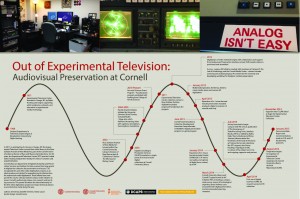AV Digitization Workflow Considerations
I had the great opportunity of attending the Association of Moving Image Archivists annual meeting and discovered a few things. First, Cornell University Library is at a good place in developing an audiovisual preservation workflow. With an established AV digitization service point and our first ingestion into CULAR on the horizon, DCAPS continues to expand and shape very innovative, yet practical goals. This is one of the biggest steps facing the AV archiving community and I was happy to share some of the progress we’ve made with the larger field at AMIA. It was very encouraging to see so many sympathetic nods.
With the help of Danielle Mericle, Mickey Cassad and Manolo Bevia, I put together timeline that charted the lifespan of the Experimental Television Center Collection from inception to magnetic carriers to digitization and finally, to archival repository. I used the life of the collection as an example of how CUL, like many institutions, created a programmatic approach to AV preservation out of related projects over the course of several years. I thought I would share the poster, since I found it to be an inspiring, long-view of the AV work that has been happening here at CUL.
I also would like to report on the most recent developments of the Advanced Media Workflow Association’s work in progress, AS-07, which is exploring the MXF codec as a preservation standard video (and/or audio) wrapper. Although there is a good debate going on about it, there would be several advantages to using MXF, including variations of lossless or partial-loss compression types, areas for embedded metadata, closed-captions, associated images and more. Chris Lacinak (AVPS), George Blood (George Blood LP), and James Snyder (LC, NAVCC) discussed positive considerations with using MXF, which could be useful to us here in CUL. Being able to embed basic technical and descriptive metadata in a video file would be tremendously advantageous. Plus, several tools coalescing around this codec are coming from the emerging open-source, command-line utility community. (as seen at AMIA/DLF Hack Day 2014) **Feedback is welcome regarding MXF for preservation.
We have also expanded the DCAPS website to include detailed information about our AV digitization lab, including capabilities and pricing. Don’t hesitate to contact us if you have questions or need technical assistance: http://dcaps.library.cornell.edu/services/digitization/av
Finally, there is much to be done to ensure the preservation of our rapidly-aging, unique media items and we are now gathering data for our AV Preservation Initiative. In partnership with CIT, this will help establish a bird’s-eye view of the AV landscape here at Cornell. Many of the unit libraries have spoken up regarding their unique AV materials and collections, but I continue to encourage anyone on campus with time-based media (whether it’s analog or digital-born) used for teaching and/or research to please complete our brief survey:
https://cornell.qualtrics.com/SE/?SID=SV_08GMajZtD6JFx2J
Have a great week-
Tre Berney

